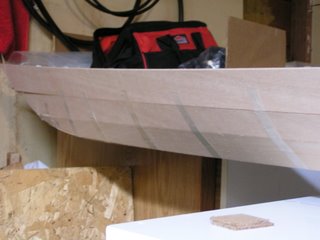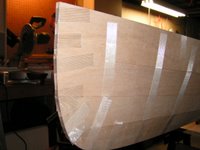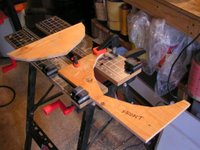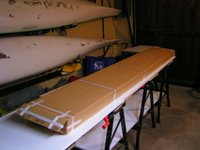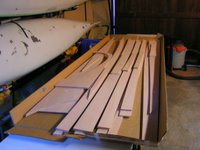I have been working on the butt joints for a few days and I have learned some important lessons:
1) Cover everything that might possibly come into contact with epoxy in plastic! This is the most important tip for anyone working with epoxy and could save you hours of stressing as you try to pry that brick or piece of plywood off your work. It is amazing how much epoxy will squeeze out after you have applied weight to the fiberglassed joints while they cure and it is just looking for something to stick to. I used grocery bags and packing tape to cover everything in sight and I had no problems.
2) Don't apply too much epoxy to the butt joints. It does not take much epoxy to wet-out the fiberglass and adding too much will only mean you will have more excess to remove later. Also, the idea of the fiberglass/epoxy joint is to keep the fiberglass in close contact with the plywood. If you have too much epoxy, the fiberglass tape could "float" off the surface of the wood and the joint will be weaker as a result. Remember that you will cover these joints over with another layer of fiberglass and epoxy later, so they don't have to be ready to face the elements at this stage.
3) Buy a cheap digital scale. After I did my first batch of butt joints I discovered there was lots of left-over epoxy going to waste. This was because the pumps that are supplied only measure a large fixed volume. To make smaller batches of mix, a digital scale is great. But you need to be careful to adjust the resin : hardener ratio appropriately. If measuring by volume it is 2 : 1, but the proper ratio for the
System Three epoxy by weight is 100 : 44. I found that 25 grams of resin mixed with 11 grams of hardener was more than sufficient to do 8 butt joints. The epoxy I save now might come in handy later if the experiences of others are any indication.
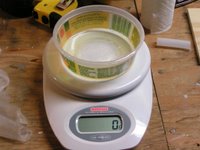 4) Use a squeegee to remove air bubbles and excess epoxy from under the Mylar before you weight the joint down.
4) Use a squeegee to remove air bubbles and excess epoxy from under the Mylar before you weight the joint down. I found that the tongue depressors that came with the kit are great for working bubbles out to the edge of the Mylar sheet. Keep in mind that you will never get out all the bubbles, but you want to get as many of the big ones as you can. Also, the more excess epoxy you squeeze out and wipe up now, the less scraping you will have to do later.
5) Remove excess epoxy while it is soft. I can't stressed this enough. It is much, much easier to wipe, scrape, or cut it off before it cures to full hardness. I purchased a furniture scraper (one with a long handle and a ~3cm (1") carbide steel blade) from a "Big Box store" on the advice of Doug, and it has worked great for cleaning up the edges of the panels. In fact, it works so well you can even use it to clean up the edges well after the epoxy has cured, as I had to do on several occasions when I did not plan ahead so well.
6) Plastic photocopy sheets work just as well as Mylar. You will soon discover that the Mylar supplied with the kit is not nearly enough to do the job, or at least in my case it wasn't. So rather than trying to re-use sheets that I had gummed up, I bought some plastic sheets from my local photocopy place and cut them to size. In the end I actually liked them better than the Mylar because they were more supple and allowed me to work out the air bubbles more easily.
7) Remove all blemishes / factory stamps from the wood before you start. Even if you think you can do it later because it is on the other side, don't risk it. The epoxy has a nasty way of getting under and around everything, so it
will get to the underside of the joint and could make that stamp a permanent resident on you hull or deck.
8) Buy good quality sandpaper. I purchased some cheap sandpaper to remove the stamps and to sand down my epoxy, but it was constantly clogging up and made the job a real headache. I then purchased some higher quality stuff from the "Big Box" and it was so much better. No more clogs and the job went quickly and easily. Just remember to wear a respirator when sanding the epoxy.
9) Have a pot of diluted vinegar handy for cleaning your gloves. As already stated, I found that the epoxy had a way of getting everywhere, especially on my gloves. This meant that unless I cleaned it off, it was eventually going to coat every surface in my shop. By dipping my hands in diluted vinegar every now and again then drying off with a towel I was able to keep this to a manageable level.

